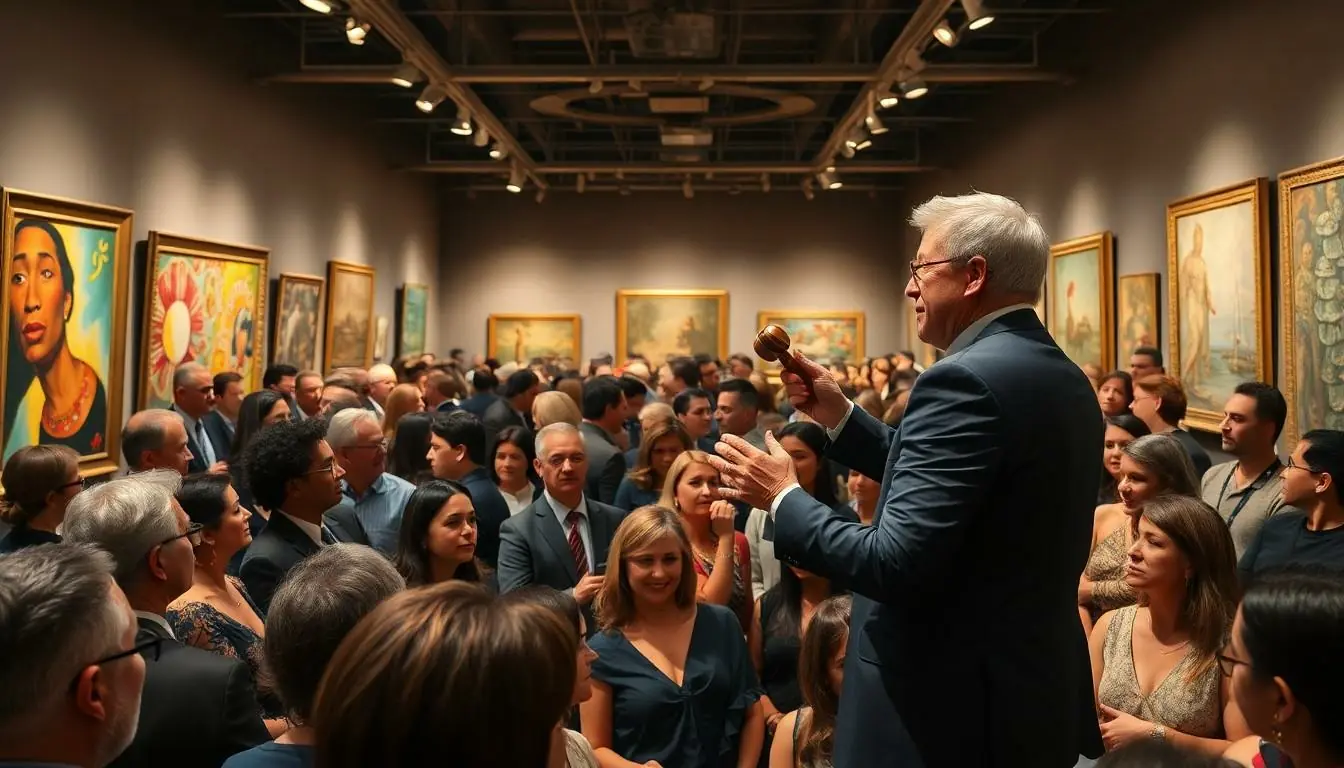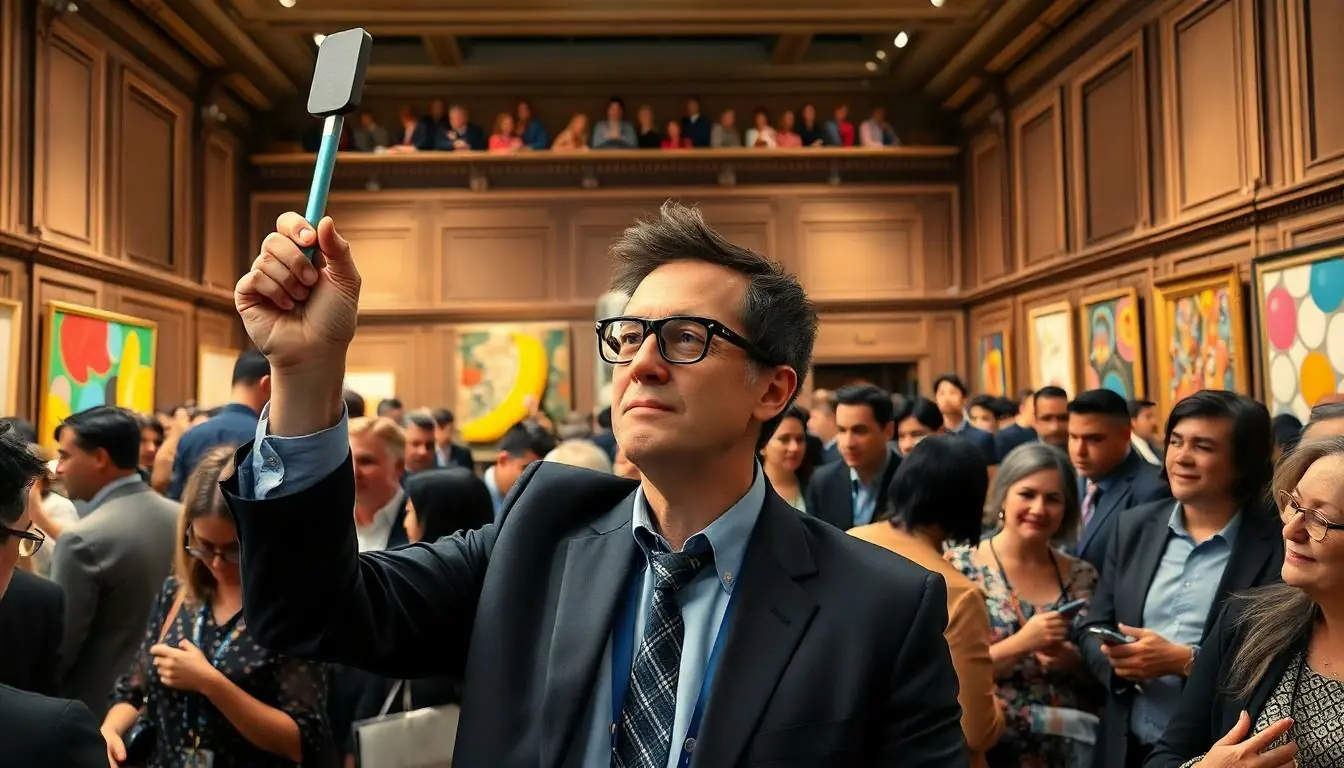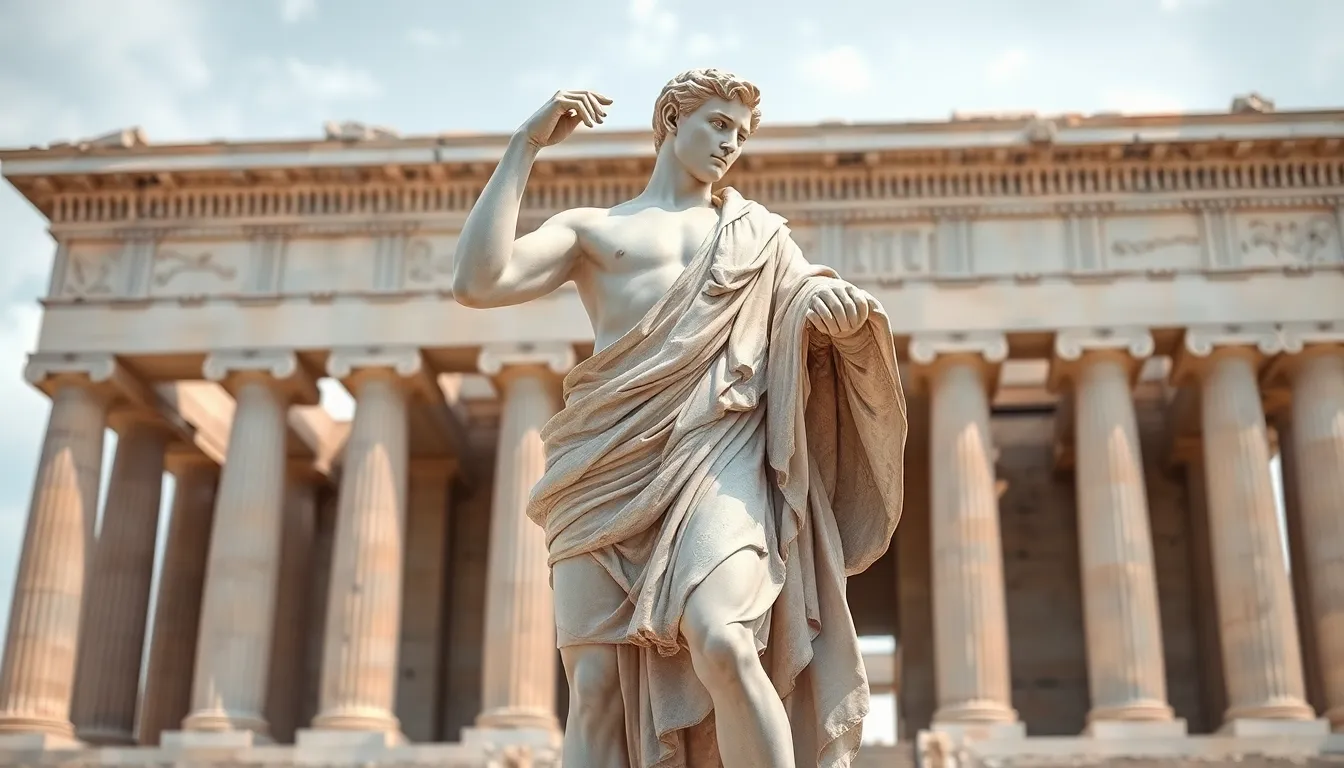In a world where a banana taped to a wall sold for thousands, modern art auctions have become the playground for the bold and the bewildered. They’re not just about fancy paintings and sculptures; they’re a thrilling spectacle where creativity meets high stakes. Picture this: art enthusiasts, collectors, and curious onlookers gather, each hoping to snag a piece of genius—or at least a conversation starter for their next dinner party.
Table of Contents
ToggleOverview of Modern Art Auctions
Modern art auctions serve as dynamic platforms where creators and collectors converge. These events showcase a variety of artworks, ranging from traditional pieces to avant-garde installations. Limitless creativity fuels bidders’ enthusiasm as they seek to acquire items perceived as investments or novelties. Often, the setting encapsulates high energy, drawing in not just serious collectors but also casual observers.
Sotheby’s and Christie’s, two renowned auction houses, lead the market, hosting significant events throughout the year. These auctions frequently feature record-breaking sales, capturing headlines and exciting art aficionados. For instance, in 2021, a digital artwork by Beeple sold for $69 million, highlighting modern art’s evolving nature.
Participants engage in bidding wars, driven by passion and a desire to own unique art pieces. Many artworks, like Banksy’s satirical pieces, spark discussions about artistry and societal issues. Auction catalogs provide essential insights, detailing the provenance and significance of each piece.
Noteworthy trends include the rising prominence of online auctions, which have opened doors to broader audiences. Digital platforms enable remote participation, allowing collectors worldwide to compete for coveted items.
Art as an investment grows more popular, with buyers considering modern art’s long-term value. Many view such arts not just as decoration but as status symbols reflective of personal taste. Market fluctuations and the distinctiveness of the artwork heavily influence its monetary value.
Overall, modern art auctions present a fascinating intersection of commerce, culture, and creativity, reflecting society’s shifting landscape.
Key Players in the Modern Art Auction Market

Modern art auctions are influenced by various key players that shape the dynamics of the market. These players include prominent auction houses and discerning collectors.
Auction Houses
Leading auction houses like Sotheby’s and Christie’s dominate the modern art auction landscape. They establish the stage for high-profile sales, attracting global attention with their exceptional marketing strategies. Professionals at these houses curate auctions to highlight noteworthy artists, such as contemporary creators and established masters. Recent record sales exemplify their impact, with pieces fetching millions and elevating perceptions of modern art. The houses facilitate the entire process, from valuations to bidding, enhancing the excitement of the auction environment. Online platforms introduced by these houses further broaden participation, allowing bidders worldwide to engage in real-time.
Collectors and Investors
Art collectors and investors play a crucial role in the modern art auction scene. Passionate individuals often shape market trends by driving demand for specific artists or styles. They range from long-time enthusiasts to first-time bidders exploring investment opportunities. Collectors seek artworks that resonate personally and also hold potential financial value. Investors approach auctions with strategies in mind, viewing modern art as both a tangible asset and a status symbol. Enthusiasts participate in bidding wars, showcasing not only their financial capability but also their commitment to supporting artistic innovation.
Trends Influencing Modern Art Auctions
Modern art auctions are influenced by a range of contemporary trends, each shaping the buying and selling experience.
Digital Platforms and Online Bidding
Digital platforms revolutionize the auction experience. Increased accessibility through online bidding allows collectors to participate from anywhere in the world. Auction houses like Sotheby’s and Christie’s have adapted to this trend, launching user-friendly online bidding systems that cater to tech-savvy buyers. This shift enables a more diverse range of artworks to reach wider audiences. Bidders can now view live auction events in real time from the comfort of their homes. Significant transactions, like Beeple’s $69 million digital sale, demonstrate this transformation’s impact on the market. Participants can engage with artists and galleries, fostering a community around each artwork.
Increasing Global Participation
Global participation expands rapidly in the realm of modern art auctions. An increasing number of collectors from emerging markets, especially in Asia and the Middle East, contribute to this trend. Diverse backgrounds enrich the bidding environment by introducing a wider variety of tastes and preferences. Many newer collectors view modern art as an investment opportunity, driving demand for unique pieces. Auction houses capitalize on this by curating international exhibitions that feature both renowned and lesser-known artists. With the internet bridging geographical gaps, more bidders join from various countries than ever before. This international interest augments competition and elevates the overall prices at auction.
Notable Modern Art Auction Sales
Significant modern art auction sales underscore the market’s vibrancy and the shifting nature of art valuation. In March 2021, a digital artwork by Beeple, titled “Everydays: The First 5000 Days,” fetched a staggering $69 million at Christie’s, marking a pivotal moment for digital art. This sale illustrated the growing acceptance of NFTs in the traditional auction world.
Another remarkable sale occurred in November 2017 when a Rothko painting, “No. 7,” sold for $81.9 million at Sotheby’s, reaffirming the allure of established artists in the modern art scene. High profile prices like these attract media attention and highlight the financial stakes involved in contemporary art collections.
Prominent artists also command impressive prices. In 2019, a piece by Jean-Michel Basquiat, “Untitled,” achieved $110.5 million at Sotheby’s, setting a record for American artists. Such sales stimulate interest among collectors and reinforce the perception of modern art as both investment and cultural capital.
International auction records continue to rise, as seen at a recent Phillips auction, where a Jeff Koons piece sold for $91 million. Global interest in modern art emphasizes a dynamic, interconnected market fueled by collectors spanning continents. Emerging markets significantly contribute to the competitive environment, with bidders from Asia and the Middle East increasingly participating in high-stakes auctions.
Data from 2021 auction seasons demonstrates a trend towards record-breaking sales. A total of 43 artworks sold for over $10 million at various auctions that year, showcasing the evolving landscape of modern art and the demand for unique and provocative pieces. Notable events include a street art piece by Banksy, which self-destructed after being sold for $1.4 million, further capturing public fascination and debate surrounding modern art.
Modern art auctions encapsulate a vibrant intersection of creativity and commerce. These events not only reflect the evolving tastes of collectors but also highlight the dynamic nature of the art market. With record-breaking sales and the rise of digital art, the landscape continues to shift, inviting both seasoned buyers and newcomers to participate. As emerging markets gain prominence, the excitement surrounding these auctions is likely to grow. This captivating world not only showcases unique artworks but also fosters a deeper appreciation for the diverse expressions of modern art.





